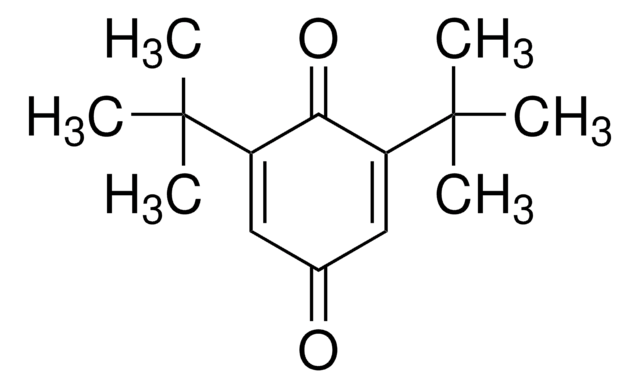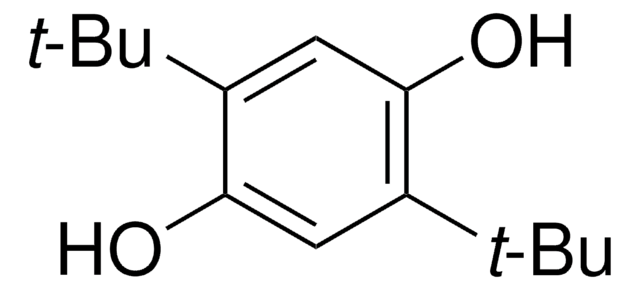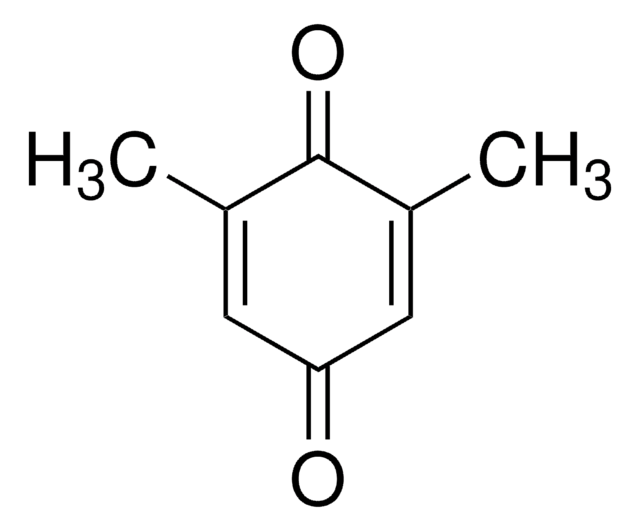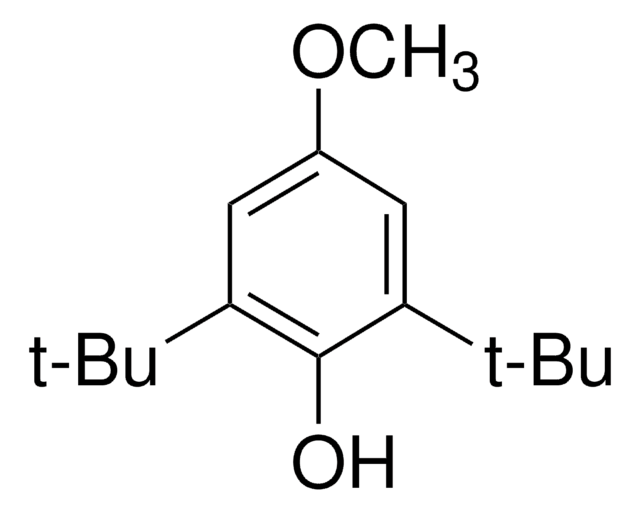All Photos(2)
About This Item
Linear Formula:
[(CH3)3C]2C6H2(=O)2
CAS Number:
Molecular Weight:
220.31
EC Number:
MDL number:
UNSPSC Code:
12352100
PubChem Substance ID:
NACRES:
NA.22
Recommended Products
Assay
99%
mp
152-154 °C (lit.)
functional group
ketone
SMILES string
CC(C)(C)C1=CC(=O)C(=CC1=O)C(C)(C)C
InChI
1S/C14H20O2/c1-13(2,3)9-7-12(16)10(8-11(9)15)14(4,5)6/h7-8H,1-6H3
InChI key
ZZYASVWWDLJXIM-UHFFFAOYSA-N
Related Categories
General description
2,5-Di-tert-butyl-1,4-benzoquinone (DTBBQ) is an 2,5-disubstituted quinone. It is an antibacterial compound. It has been isolated from marine Streptomyces sp. VITVSK1. Pressure dependance on the intramolecular and intermolecular migration rates of Na+ and K+ in a 2,5-di-tert-butyl-1,4-benzoquinone ion pair have been evaluated by using a high-pressure EPR technique.
Signal Word
Warning
Hazard Statements
Precautionary Statements
Hazard Classifications
Eye Irrit. 2 - Skin Irrit. 2 - STOT SE 3
Target Organs
Respiratory system
Storage Class Code
11 - Combustible Solids
WGK
WGK 3
Flash Point(F)
Not applicable
Flash Point(C)
Not applicable
Personal Protective Equipment
dust mask type N95 (US), Eyeshields, Gloves
Choose from one of the most recent versions:
Already Own This Product?
Find documentation for the products that you have recently purchased in the Document Library.
Customers Also Viewed
Catalytic aerobic deamination of activated primary amines by a model for the quinone cofactor of mammalian copper amine oxidases.
L M Sayre et al.
Methods in enzymology, 258, 53-69 (1995-01-01)
L C Rome et al.
The Journal of physiology, 526 Pt 2, 279-286 (2000-07-15)
1. The rate at which an isometrically contracting muscle uses energy is thought to be proportional to its twitch speed. In both slow and fast muscles, however, a constant proportion (25-40 %) of the total energy has been found to
Vinay Gopal Jannu et al.
International journal of bioinformatics research and applications, 11(2), 142-152 (2015-03-20)
The incidence of bacterial disease has increased tremendously in the last decade, because of the emergence of drug resistance strains within the bacterial pathogens. The present study was to investigate the antibacterial compound 2,5-di-tert-butyl-1,4-benzoquinone (DTBBQ) isolated from marine Streptomyces sp.
L Missiaen et al.
European journal of pharmacology, 227(4), 391-394 (1992-12-01)
Specific inhibitors of the endoplasmic-reticulum Ca2+ pump will deplete intracellular stores and are therefore useful to study the role of store depletion on plasma-membrane Ca2+ permeability. We now report that the Ca(2+)-pump inhibitor 2,5-di-(tert-butyl)-1,4-benzohydroquinone (tBuBHQ) reduces the passive Ca2+ leak
R J Dolor et al.
The American journal of physiology, 262(1 Pt 1), C171-C181 (1992-01-01)
We have investigated the role of the intracellular Ca2+ pool in regulating Ca2+ entry into vascular endothelial cells. The intracellular Ca2+ pool was mobilized using either thapsigargin (TG) or 2',5'-di(tert-butyl)-1,4-benzohydroquinone (BHQ), inhibitors of the endoplasmic reticulum Ca(2+)-adenosinetriphosphatase (ATPase). Mobilization of
Global Trade Item Number
| SKU | GTIN |
|---|---|
| 419648-25G | |
| 419648-5G | 4061831820256 |
Our team of scientists has experience in all areas of research including Life Science, Material Science, Chemical Synthesis, Chromatography, Analytical and many others.
Contact Technical Service















